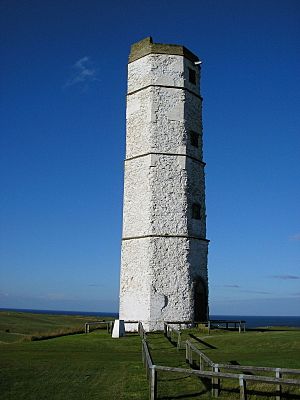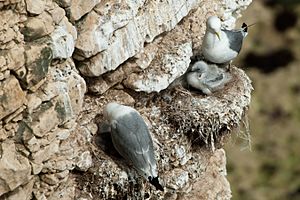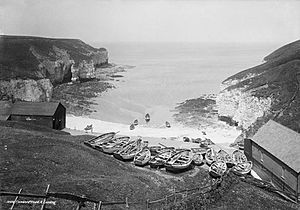Flamborough Head facts for kids
Flamborough Head is a famous piece of land that sticks out into the North Sea on the Yorkshire coast of England. It's about 8 miles (13 km) long and sits between Filey and Bridlington bays. This area is known for its tall, white cliffs made of chalk.
At the top of the cliffs, you can see two lighthouses. The older one was built in 1669 and is the oldest complete lighthouse still standing in England! The newer Flamborough Head Lighthouse was built in 1806. The cliffs are also a very important home for thousands of seabirds. They are also special because of their unique geology (the study of rocks and how the Earth is formed).
Contents
Protecting Flamborough Head
Flamborough Head is a very special place, so it has been given several important protections.
Special Area of Conservation
The British government has named Flamborough Head a Special Area of Conservation (SAC). This means it's a strictly protected area. These sites are part of a European network that helps protect important habitats and species. Flamborough Outer Headland, which is about 83 hectares (210 acres), is also a Local Nature Reserve. The Yorkshire Wildlife Trust helps look after the Flamborough Cliffs Nature Reserve, which is part of the headland.
Site of Special Scientific Interest
The cliffs at Flamborough Head are also a Site of Special Scientific Interest (SSSI). This means they are important for both their geology and their wildlife. This special protection started in 1952. The SSSI area stretches from Sewerby all the way around the headland to Reighton Sands.
Amazing Geology
Flamborough Head is the only chalk sea cliff in the north of England. The rocks here show layers from the Jurassic period and Cretaceous period, which means they are between 100 and 70 million years old! These dramatic white cliffs are very different from the flat coast to the south.
The chalk cliffs at Flamborough have more caves than any other chalk site in Britain. Some of these caves go back more than 50 metres from the coast! You can also see cool rock formations like stacks (tall columns of rock), natural arches, and blowholes.
Wonderful Birds
Many seabirds, like northern gannets, kittiwakes, and Atlantic puffins, come to the cliffs to breed. On the north side of the headland, you'll find Bempton Cliffs, which has an RSPB nature reserve and a visitor centre.
Long ago, people used to shoot seabirds at Flamborough Head. But in 1868, a professor named Alfred Newton spoke out against it. The local Member of Parliament (MP), Christopher Sykes, then helped create the Sea Birds Preservation Act 1869. This was the first law in the United Kingdom to protect wild birds!
Because Flamborough Head sticks out into the sea, it's a great spot to see migrant birds in autumn. Many birdwatchers come here to watch seabirds from near the lighthouse. Later in autumn, they look for land birds hiding in the hedges and valleys. Flamborough Head even has its own bird observatory.
Battle of Flamborough Head (1779)
A famous sea battle happened near Flamborough Head during the American Revolutionary War. On September 23, 1779, a group of ships from France and America fought against two British Royal Navy ships.
In this battle, the American ship USS Bonhomme Richard and its allies captured the British ships HMS Serapis and Countess of Scarborough. This was a very well-known moment in the naval career of Captain John Paul Jones. There's a special marker near the lighthouse that remembers this battle.
Interesting Places Nearby
Danes Dyke
Danes Dyke is a 2-mile (3.2 km) long ditch that runs from north to south. It cuts off the outer part of the headland, making the area inside (about 5 square miles (13 km2)) very easy to defend. This includes two beaches where boats can be launched, called North and South Landings. Even though it's called "Danes Dyke," it's actually much older than the Vikings! It was built in prehistoric times. When it was dug up in 1879, Bronze Age arrowheads were found. It is also a Local Nature Reserve.
Thornwick Bay
On the north side of Flamborough Head, you'll find Thornwick Bay. This bay has a rocky beach surrounded by cliffs. The name Thornwick comes from an old Norse word for 'bay'. So, Thornwick Bay actually means "Bay Bay"! The northern tip of the bay is called Thornwick Nebb, where Nebb also comes from an Old Norse word meaning 'promontory' or 'headland'.
Lightning Strike
On the evening of August 23, 2006, a powerful lightning bolt hit a part of the cliffs. This caused about 100 tonnes of rock to break off and fall into the sea!
See also
 In Spanish: Cabo Flamborough para niños
In Spanish: Cabo Flamborough para niños





